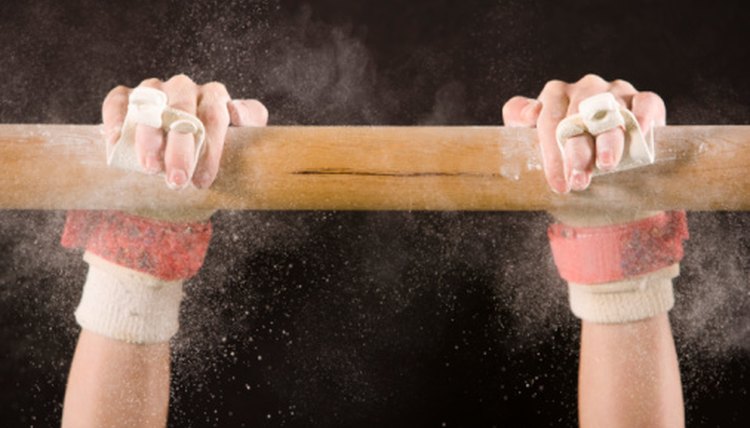History of the Uneven Bars in Gymnastics

Although the history of gymnastic competitions dates to classical civilization, the parallel uneven bars are a 20th century addition to the sport. The uneven bars evolved naturally in response to the growing visibility of women in professional sports. In a sport that was originally designed to showcase masculine strength and endurance, the uneven bars provides a showcase for feminine grace and physical agility.
Origins
Female participation in professional gymnastics began in the 19th century, when women performed activities modeled after the male division. Events such as the parallel bars focused on strength and stamina with little emphasis on artistic movement. The benefits of adjusting the parallel bars to an uneven position was first mentioned by a Frenchman named Amoros in “Manuel d’education Physique et Morale,” according to Gym Media.com. The uneven bars were introduced publicly in 1934 at the World Championships in Budapest, and were demonstrated at the Olympics two years later. The sport wasn’t included as an Olympic event until 1952.
Design
The uneven bars are made from fiberglass and wood, and are typically mounted from a springboard. The standard width is 94.5 inches, while the long and short bars extend 7.5 feet and 5 feet above the ground, respectively, says Dan Gutman, author of “Gymnastics.” The current distance between the two bars is between 5 and 6 feet. However, the distance is adjustable and has been varied in different decades and countries, sometimes affecting how a particular trick is performed. The size of the gymnast also influences the distance of the uneven bars. These variations have been reflected in the positioning of the apparatus as the average age of professional female gymnasts has decreased over time.
Routines
The uneven bars were developed to emphasize feminine physicality, so early performances incorporated artistic, ballet-inspired movements, says Gutman. The sport gradually evolved to showcase performance skills along with grace and flexibility, integrating more acrobatics into the routines, such as swings, twists and transitions from one bar to the other. Skills are divided into levels A through E, starting with basic swings and handstands and progressing to difficult hand changes and aerial twists. New skills are named for the gymnast who introduced them, such as the Comaneci and Shaposhnikova.
Evolution
The acceptance of the uneven parallel bars as a legitimate gymnastics event has resulted in a more standardized system of routines and scoring. In a 30-second routine, the gymnast is required to use both bars, performing no more than five moves consecutively on one bar. In the 1960s and 1970s, brief pauses, or stops, were allowed within the routine, but those stops have since been eliminated and routines are expected to be continuous. Gymnasts also are required to include a minimum of two airborne skills. Performers begin with a perfect score and lose points based on factors such as form and level of difficulty. Nadia Comaneci was the first gymnast to score a perfect 10 on the uneven bars at the Olympic Games in 1976.
References
Writer Bio
Ess Loumarr is a freelance writer from New England and has worked as a copywriter since 2008. Her short fiction has appeared in the "Spectrum Anthology" at the University of California, Santa Barbara. She received a Bachelor of Arts in English literature and composition at Columbia University, as well as prizes for playwriting and fiction.
